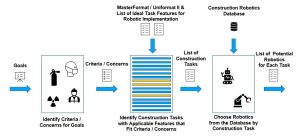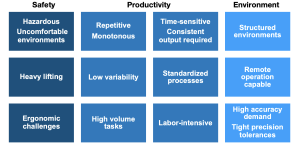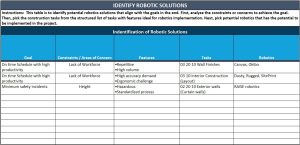3 Identify Opportunities
Objective: This step identifies opportunities and lists potential robotics based on goals and construction tasks that are highly relevant to achieving those goals. Figure 3-1. shows the process map for identifying opportunities to use construction robotics.
 Figure 3.1. Process of Opportunities
Figure 3.1. Process of Opportunities
Identify Criteria/Concerns for Goals:
The output of Chapter 2 is a list of core automation goals for implementing construction robotics in a project. These goals are the key inputs for the team to identify criteria or concerns of the goals for applying robotics. The team needs to analyze the criteria or concerns of the selected core goals based on needs, given conditions, and experience. For example, if the core goal of the construction project is safety, then these safety-related criteria or concerns may include performing tasks in high areas or tasks that are performed in a limited space. The output will be a set of criteria and/or concerns about the core goals.
Identify Applicable Construction Tasks:
Next, the team needs to select the project’s construction tasks that align with each goal’s criteria and/or concerns. In this phase, two external sources of information are needed as references. The first one is the list of features ideal for robotics implementation. An example list of features can be found in Figure 3-2. Users can select appropriate features as the basis for filtering tasks based on the list of features, construction experience, and related knowledge. For the second resource, the team needs a list of construction tasks either from MasterFormat or Uniformat II or any additional structured list of construction tasks. One example list of tasks can be found in Appendix B.

Figure 3.2. List of features
Find Potential Construction Robotics:
Then, the team picks the robotics from a database according to the list of construction tasks that meet the features. The list of robotics can be found in Appendix C. By following this process, the construction team can obtain a list of multiple robotics that can potentially perform those tasks, which can be used for the next step to evaluate each robotic further. The output of this step is a list of robotics that have the potential to perform those construction tasks identified. The template worksheet for this whole step can be found in Appendix D. An example use of this worksheet is shown below in Table 3-1.
Table 3.1. Identify Robotic Solutions Worksheet Example


